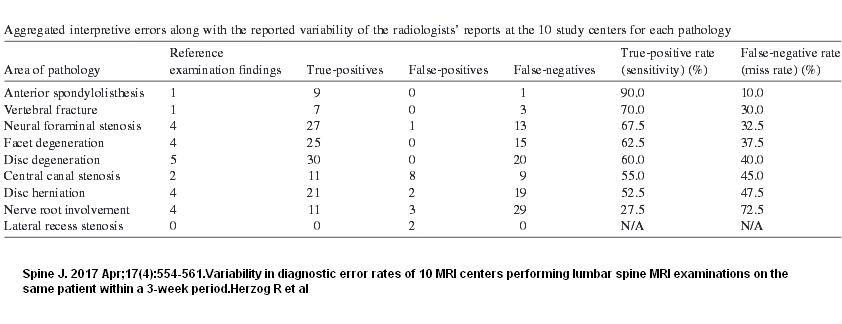The MRI GOD is struck another blow – interpretation is so variable, the authors states “As a result, the authors conclude that where a patient obtains his or her MRI examination and which radiologist interprets the examination may have a direct impact on radiological diagnosis, subsequent choice of treatment, and clinical outcome.” Now that is a scary prospect.
Spine J. 2017 Apr;17(4):554-561. doi: 10.1016/j.spinee.2016.11.009.
Variability in diagnostic error rates of 10 MRI centers performing lumbar spine MRI examinations on the same patient within a 3-week period.
Herzog R, Elgort DR, Flanders AE, Moley PJ.
https://www.ncbi.nlm.nih.gov/pubmed/27867079
http://www.thespinejournalonline.com/article/S1529-9430(16)31093-2/pdf
- 63 year old lady with l5 sciatica
- “mild weakness in right ankle dorsiflexion 4+/5 and right great toe extension 4
+/5, reflexes were diminished, but symmetrical bilaterally (1/4), and she had a
positive dural tension (seated slump) sign on the right” - lead author considered expert in his field
- 49 findings 1/3 appeared only appeared once in 10 reports
- Fleiss kappa statistic value used to document agreement:
– 0 = no better than chance
– >0.75 excellent agreement - “all reported interpretive findings was 0.20±0.03, indicating poor overall agreement on interpretive findings”
- “number of examinations reporting the presence of a disc herniation at a given
motion segment ranged from 70% at L3–L4 to 20% at L5–S1” - “The number of study examinations reporting thecal sac compression due to a disc herniation ranged from 60% at L1–L2 to only one examination reporting thecal sac compression at L4–L5. Nerve root involvement due to a disc herniation was reported in 20% of the examinations at L2–L3, 40% of the examinations at L3–L4, and 30% of the examinations at L4–L5”
- The Fleiss kappa score for agreement on the presence of a disc herniation was −
0.02±0.23 across the five motion segments”.(POOR) - Fleiss kappa score for agreement on the presence of central canal stenosis was 0.17 ±0.32 across the five lumbar motion segments.(POORER YET)
Concluded
- “marked variability in the reported interpretive findings and an alarmingly high number of interpretive errors in the lumbar MRI reports. “
- “important pathologies are routinely underreported. For example,the study examinations demonstrated an average miss rate for disc herniation of 47.5%. “
- “high false-positive rates for specific pathologies indicate that diagnostic findings, such as central canal stenosis, may be routinely overcalled”
- overreliance on the MRI report for treatment could be disasterous
Comment – not only is serious pathology missed, I have found finding could be downplayed – ie “nerve root is only being touched by disc” – clinically this could be very important. If this was a insurance claim case, I would want my films viewed by more than one MRI site – anyone know good sites? pandora pas cher pandora pas cher


In 2012 I sent my 2 MRI scans administered at S’Toon University Hospital 2006 /2010 to XMRI – 2nd opinion radiology. ” ://www.xmri.com/ ”
the reports compared to the Saskatchewan radiologists, are like “Night and Day”
which makes me question, was this deliberately used to terminate WCB benefits?
Images easily identified as cause severe pain were “Not Reported” – furthermore, in 1999 Justice Maclean Alberta Court identified WCB Literally controls the diagnosis with their “Highly Paid” contract doctors / in-house counsel. – Justice Maclean further stated, “WCB is “NOT” a level playing field and offends the basic principles of Natural Justice.